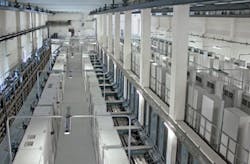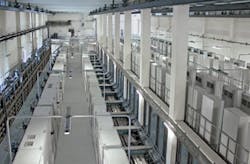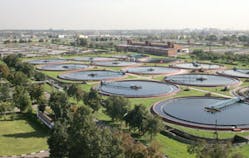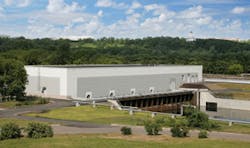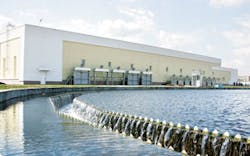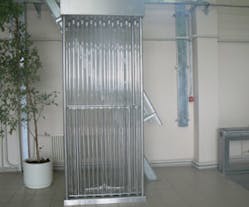Chemical free disinfection by ultraviolet (UV) treatment was successfully installed in the two largest wastewater treatment plants in Moscow, Russia. The article details how one of the world's largest UV systems was designed and installed.
The city of Moscow is continuously developing and improving its infrastructure in order to keep up with the growth of population, while minimising the environmental impact of the city's activities. Moscow's infrastructure collects the wastewater of over 14 million inhabitants into several wastewater treatment plants. The entire city's municipal and industrial wastewater is sanitised before being discharged into the natural receiving water bodies.
It is recognised that due to the large volumes of wastewater, both the chemical and micro-biological impact on the receiving water bodies should be limited as much as possible. The capacities of the Moscow wastewater treatment plants - Kuryanovskiye WWTP and Lyuberetskiye WWTP, are among the largest in Europe. In autumn 2012, the Kuryanovskiye WWTP completed the installation of world's largest ultraviolet (UV) disinfection plant, with a capacity of 3.125 million m3/day (180,000 m3/hr). The scale of the UV system, as well as the engineering and technical implementation make it a unique UV disinfection solution.
Project challenges
One of the project challenges was to limit the required civil construction works by integrating a UV disinfection system into the limited available space of an existing contact chamber, with its operational effluent discharge channel to the receiving water body. The Moscow UV system manufacturer LIT offered a UV technology platform in a compact modular UV system design to treat large amounts of water in the space-limited conditions of the Kuryanovskiye WWTP.
The supplied disinfection system was optimised to disinfect efficiently very large flows with minimum hydraulic resistance. The project demanded integration of the UV disinfection stage, without increasing the existing overall headloss profile of the WWTP.
Both criteria for civil design and hydraulic profile were successfully achieved with the installation of the system, consisting of 17 open channels.
Each channel is equipped with 5 UV banks in series, each UV bank consisting of two in parallel placed vertical UV modules. With this configuration the total hydraulic headloss over the UV system at peak flow is less than 30 cm w.c.
UV system features
The UV system is fitted with a fully automatic water level control system to maintain the proper water level inside the disinfection channel at all flow rates up to the design peak flow. It prevents the overflow of the UV system and guarantees that all water will be disinfected properly in addition it assures the overall UV system headloss to be minimised. Each UV module is equipped with an in situ mechanical cleaning system, which enhances the UV system disinfection performance, and minimises the maintenance cost.
The cleaning process is triggered by adjustable parameters (time or UV intensity) and is executed without operator interference or interruption of the UV disinfection process. The mechanical cleaning system is operated automatically, with an adjustable cleaning frequency per day.
The mechanical wiping system prevents quartz sleeve fouling build up during the UV disinfection process. It removes deposits from quartz sleeve surface by mechanical wipers, which are moved periodically along quartz sleeves. The mechanical cleaning system is actuated by a pneumatic cylinder.
The low pressure high output amalgam lamps (high-wattage lamp – 600W) installed in vertical modules, with ballast cabinets located above the UV channel, allow for compact installation, with a small UV system footprint. Such a design of UV module, equipped with low pressure high output amalgam lamps was developed specifically for large-scale WWTPs.
The choice for the new technological UV platform was driven by the small footprint of the UV plant design and the advantageous operational characteristics:
- Low power consumption;
- Long lamp life (more than 12 000 hours)
- Easy service and minimum operational and maintenance labor requirements (i.e. lamp replacement with the UV modules remaining in the UV channel).
The UV lamps in the vertical UV modules are arranged in a staggered order, to assure a reliable high intensity disinfection path.
Because of the Moscow River having a 1% probability of overflowing the WWTP, preventatively the electrical compartments are located at the second floor above the UV channels. UV disinfection proceses at the Kuryanovskiye WWTP is fully automated.
The system is equipped with an automatic dose pacing system to adjust lamp intensity, to control and accommodate for variation in water quality parameters and flow rates. All operational information about the UV system's operation is transmitted to a central control center.
Disinfection performance
A series of tests were performed after installation of the UV equipment, to determine the efficiency of the UV disinfection process, based on the actual effluent quality.
Physical, chemical and microbiological parameters of the effluents were analyzed in the Laboratory of the Moscow Center of Hygiene and Epidemiology and the Analytical Center Rosa.
The effluent samples were taken at the control point after the contact chamber, just before the effluent discharge into the Moscow River.
All tests results are compliant with the design parameter and state standards SanPiN 2.1.5.980-00 – Hygienic Regulations for Surface Water Protection.
- Total coliforms – less than 500 CFU/100 ml
- Fecal coliforms – less than 100 CFU/100 ml
- Coliphages – less than 100 PFU/100 ml.
The completion of the UV disinfection system at the Kuryanovskiye WWTP, combined with the already operating UV plant at the Lyuberetskiye WWTP count for micro-biological sanitation of two thirds of the total effluent entering the Moscow water bodies.
The total treated effluent represents 50% of the total flow of the Moscow River and 90% of its tributary – the Pekhorka River.
To prevent development of epidemiological risks in the Moscow water bodies, disinfection of the discharged wastewater is required.
The chosen method of chemical free disinfection reduces significantly the micro-biological impact of the effluent without altering the chemical composition of the receiving waters.
With the application of a fundamentally new UV technology platform, one of the world's largest UV disinfection project for treated effluent with a capacity of 3.15 million m3/day was designed and successfully implemented at the Kuryanovskiye WWTP, Moscow. The completion of the UV plant in Kuryanovskiye WWTP, in addition to the already successful operating UV plant in Lyuberetskiye WWTP since 2008, provide a reliable disinfection of the treated effluent in Moscow in accordance with the state regulations.
This significantly improves the overall sanitary conditions and reduces the epidemiological risk for the Moscow water bodies in the middle and lower part of the Moscow River.
This article was written by several authors, including Moscow Waterworks, MosvodokanalNIIproyekt, Moscow Institute of Physics and Technology and LIT. UV..
